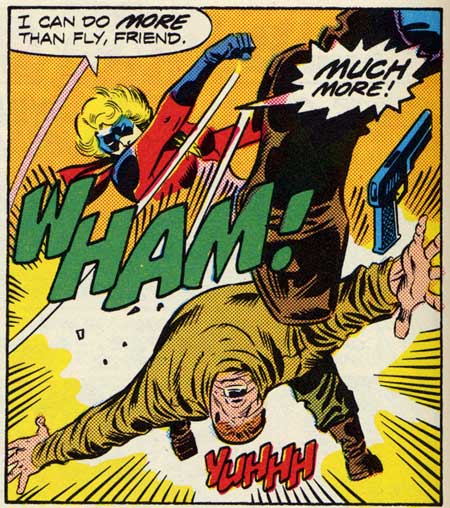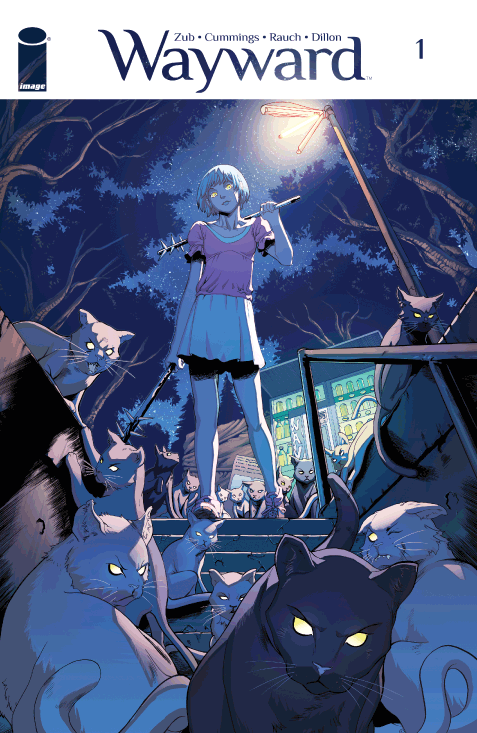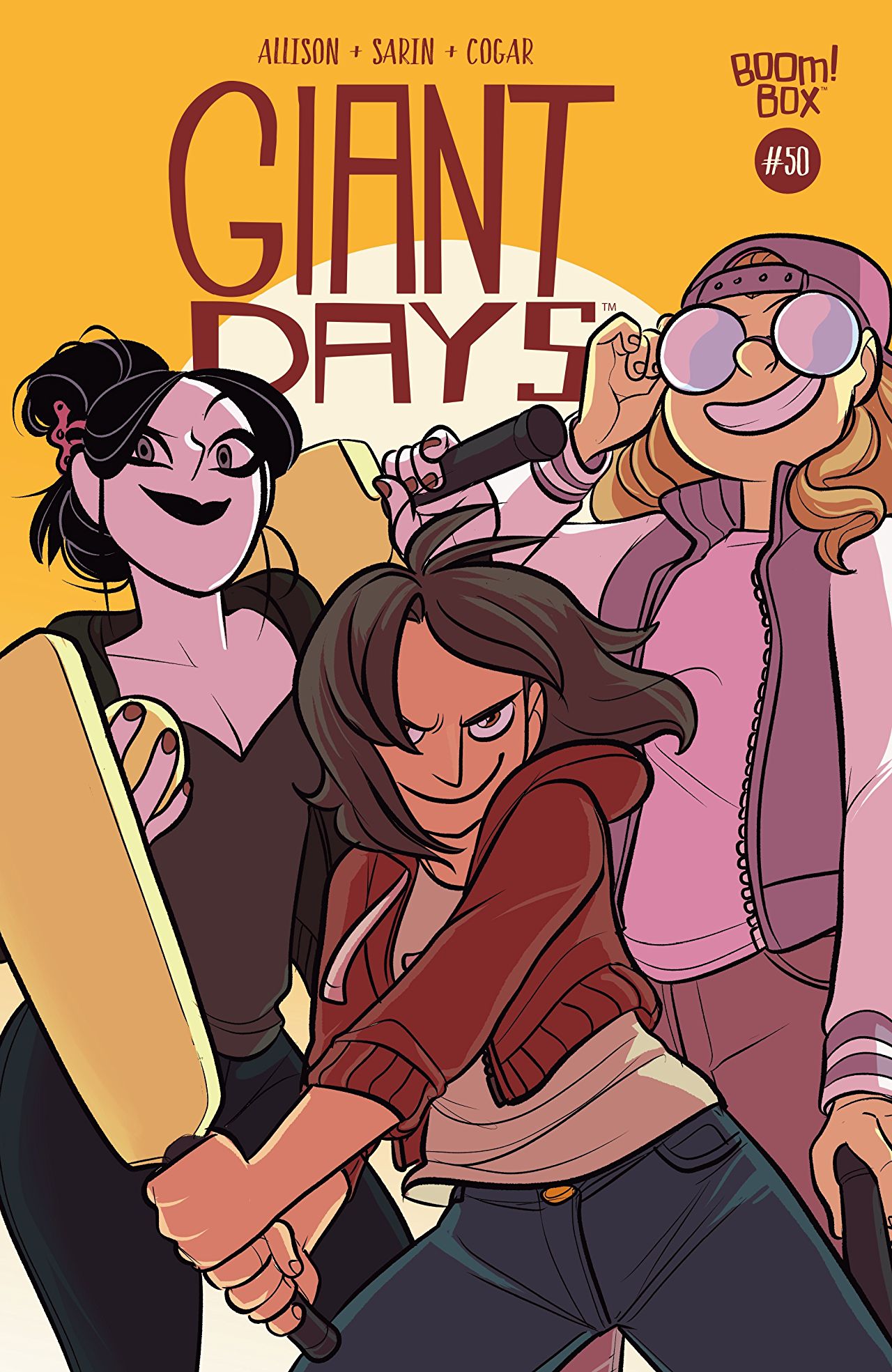Panel Review 101 w/ Mr. B
Welcome to Panel Review 101 with your professor**, Mr. Braccino! Using his hyper-intellectual power of literary analysis and uncanny knack for identifying metaphors from any distance, Mr. B will take you through significant single issues, graphic novels, and any other category of comic worthy of a keen eye and critical consideration!!! For all those that believe that comics should be, can be, and often are more than just tights and onomatopoeiac fisticuffs, well, this here’s just the column for you!!!! Welcome True Believers, and let’s hope our little seminar in comics studies goes on and on and on!!!
**Disclaimer: Joey Braccino is not an actual professor, unless you count being a really, really hard-working public high school teacher as “professorial.” If that is the case, well, thank you for your kind words!!!

Today’s Topic: Ms. Marvel #1
Objective: SWBAT close-read and analyze the debut issue of Ms. Marvel’s first solo series. In addition to common points of analysis like visual metaphor, juxtaposition, and dynamism, SW consider the inclusion of feminist ideals relevant to the Women’s Lib movement of the 1970s.
Do Now: (Optional) Read Ms. Marvel #1 (1977) by Gerry Conway and John Buscema! Also, check out Marvel Super-Heroes #13 (1966) and the first 18 issues of Captain Marvel (1969) for Carol’s initial adventures alongside the Kree warrior, Mar-Vell!
Prior Knowledge:
- Carol Danvers first debuted in Marvel Super-Heroes #13 by Roy Thomas and Gene Colan. as a US Air Force Major and NASA security chief. In these initial appearances, Danvers is presented as a no-nonsense leader interested in unpacking the mystery surround a certain Dr. Lawson (aka Captain Marvel!). No romantic links are evident between the alien superhero and our prominent female figure in the story.
- Danvers then appears in the supporting cast of Captain Marvel’s solo series under the direction of a myriad of writers. She continues her mission of finding out the truth about Dr. Lawson while, in typical caped comics style of the era, falling for his superhero counterpart, Captain Marvel.
- The romance is only teased here and there and doesn’t amount to much. Captain Marvel struggles to find an audience and Roy Thomas and Gil Kane revamp the book at #17. The ongoing threads are resolved quickly, ultimately leaving Carol Danvers out of the book for nearly a year. The character returns in her role as Security Chief in a few guest appearances while the book itself is canceled and relaunched several times throughout the 1970s, including a very successful run under Jim Starlin.
- In Danver’s last appearance as a member of the main cast in Captain Marvel #18, our eponymous hero saves Carol from a near-death experience with the Psyche-Magnetron and Yon-Rogg (sound familiar to Kelly Sue Deconnick’s Captain Marvel fans?). This would later be our divergent point for Ms. Marvel to gain her powers!
- MEANWHILE, in an era of increased social activism and a seemingly non-stop battle for equal rights and freedoms for all citizens of the country, the Women’s Liberation movement really picks up steam during the 1970s. One of the more prominent media entities in second wave feminism? Ms. magazine. Relevant perhaps?
- Hilarity, and HISTORY, ensued.
Let’s take a look:
As always, let’s start with the cover. Our eponymous heroine literally breaks through the plane of the cover, flying fist first toward the audience. Questionable costume design aside (Ms. Marvel is, after all, part of a pop culture era obsessed with Lynda Carter’s Wonder Woman…), everything about John Buscema’s cover cries bold, brave, and breaking down boundaries. Juxtaposing an image of a battle with the Scorpion (more on the villain later) with an inset of Carol Danvers at the office establishes the duality of the character to be explored throughout the book: Carol Danvers as aspiring professional in the journalism field and Ms. Marvel as smash-em-up superheroine fighting for legitimacy.
In addition to the dynamic lay-out of the cover, the text promises a “Fabulous First Issue” with “All-Out Action!” Marvel really tries to capitalize on the feminist strand running through the book with the exasperated “AT LAST! A bold new super-heroine…” Of course, the line goes on to say “in the senses-stunning tradition of Spider-Man” and the cover features the floating heads of recognizable characters J. Jonah Jameson, Mary Jane Watson, and Peter Parker himself. The inclusion of the Spider-verse as it were here proves to be a sort of contradiction that speaks to a larger issue that will plague the book and the lead character; does the fictional Ms. Marvel exist as a mere knock-off extension of her male counterpart (Captain Marvel) akin to DC’s Batgirl and, furthermore, could a Ms. Marvel title exist without the help of characters and plugs from an A-List title like Amazing Spider-Man? Whether these were editorial’s considerations in 1977 isn’t relevant to our conversation today, but it is an interested question to keep in mind during our “Women In Comics” week! One final allusion to the character of Medusa from the Fantastic Four mythos—the strong sovereign of the Inhumans and partner/wife to Black Bolt—and we’re off to the races!

Ms. Marvel #1 opens—for all intents and purposes—as epically as possible. Ms. Marvel cuts the caption in half as she swoops onto the scene. The narrator goes on to compare our heroine to “the Valkyrie, [the] guards of Valhalla,” lending a mythological weight to the introduction. The epic title to this story? “THIS WOMAN, THIS WARRIOR,” painted in stark black and red. The dynamism of the cover continues immediately onto this first spread. Upon her entrance, the narrator is sure to emphasize that “her name is her own,” initiating the theme of self-reliance that will ground much of the book.
As is often the case with these introductory issues, the opening set-piece features our eponymous superhero showcasing his/her powers as he/she takes on a group of thugs. What sets this action sequence apart from other superheroic debuts, however, are the reactions of both the criminals as well as the bystanders. Ms. Marvel effectively dispatches of the would-be bank robbers with an impressive mix of bravado and brute force, taking out two with one punch and preventing a getaway a la Superman in Action Comics #1 (i.e.: car-smashing 101). Ms. Marvel also demonstrates a strange “Seventh Sense” power that will disappear from later iterations of the character, but probably has its origins in the notion of “Women’s Intuition.” The less said about that toss-away power, the better…
Of course, even as they are buffeted and embattled, the crooks take the time to call Ms. Marvel a “dame in a costume” and a “broad,” demonstrating shock not necessarily at the arrival of a superhero, but that said superhero is a “she” in the first place. After taking down the crooks, Ms. Marvel is confronted by the police and the citizens of New York. Some are impressed, remarking that “that little lady makes Lynda Carter look like Olive Oyl!” (Marvel’s dig at their Distinguished Competition, no doubt), while others are convinced that a female superhero is nothing more than “an act! A publicity stunt!” The cops demand that the “lady” come in for questioning before Ms. Marvel flies away, leaving the crowd to “breathe… and wonder!” Buried in the panels is a remarkable moment that writer Gerry Conway handles perfectly:

Little Suzy’s comments capture exactly what Ms. Marvel means for the Marvel Universe at large. In a city frequented by Iron Man, the Fantastic Four, and mutants galore, a hero like Ms. Marvel—an independent, powerful warrior that literally soars—has never before been seen by these people. And that’s a poignant introduction if there ever was one.
The rest of the issue features two separate story threads; one features Carol Danvers taking on a job at the Daily Bugle as the new editor of a magazine for women; the other features Ms. Marvel taking on the Scorpion. In both threads, the character comes with images and issues of male chauvinism and fights to affirm her power (not establish—she is already powerful).

In the Daily Bugle thread, Conway brings the feminist ideology on heavy as Carol lays into J. Jonah Jameson for equal pay and an actual mission for her magazine. Carol reiterates her qualifications (worth in the workplace) and establishes, in the climax of the scene, that it’s MS. Danvers, not Miss or Mrs. She is beholden to no one, as evidenced by the relative inconsequence of the male figures in the scene. J. Jonah Jameson—no matter how many cigars he waves around in her face—cannot bully Carol into a certain type of content (“new diets and fashions and recipes”) or a low salary. Peter Parker, Marvel’s most famous character, gets one line in the entire book.
Mary Jane Watson and Carol Danvers then engage in an almost-Bechdel-Test-busting conversation that ranges from referencing Captain Marvel and Peter Parker to exploring Carol’s time in the military and at NASA and her passion for writing. It’s a natural conversation and remarkable in both its length (nearly two pages) and its character composition. While it doesn’t pass the Bechdel test outright, the thrust of the conversation is Carol Danvers’ successes and failures and goals.
The other thread features a by-the-book supervillain story of intrigue. The reasons behind Scorpion’s presence in a Ms. Marvel book are tangential at best; he’s angry at J. Jonah Jameson for ruining his life in some back-issue of Amazing Spider-Man. Given Jameson’s role in Danvers’ life, I suppose it’s relevant, but let’s face it; at this point, Ms. Marvel doesn’t exactly have an extensive rogues gallery. What does interest me is the choice of the Scorpion. A supervillain whose primary weapon is a long, phallic tail that he swings around all willy nilly does battle with our bold new heroic face of feminism at Marvel? I’m sure we can see the symbolism.

Needless to say, Ms. Marvel conquers the Scorpion in a bout of fisticuffs unlike any. To get there, however, Ms. Marvel must first weave her way through a secret headquarters littered with booby-traps and pitfalls, which she handles with grace and intelligence to match her outward strength. During the fight, Scorpion remarks on Ms. Marvel’s similarities to Captain Marvel. This triggers Ms. Marvel’s memories, and she recalls the accident that granted her the powers of Captain Marvel and inspired her to fashion her costume after his. Of course, she has spent most of the issue without this memory, in a way reaffirming that “Her name is her own” claim from the initial narration. While yes, much of her character origin is an extension of her male counterpart, she’s been fighting crime without that knowledge for the majority of the text so far.
The amnesia angle is interesting in that it sets up a “search for identity” narrative for the book. Essentially, Ms. Marvel and Carol Danvers do not know that they are one and the same; when one is “working,” the other assumes she’s just blacked out. Conway is using the narrative device of amnesia here as a metaphor for, as he puts it in the MS. Prints letters column, “the modern woman’s quest for raised consciousness, for self-liberation, for identity.” Interestingly, Carol Danvers and Ms. Marvel both work to affirm their self-efficacy in their separate occupations, unaware that the other is working toward similar goals. Until they realize this, the story can never be complete. The larger suggestion here might be that all women—including Mary Jane!—must work together to truly accomplish the sort of boundary-breaking that the movement desires.
Wrap-Up:
Though Ms. Marvel certainly isn’t the first female superhero to earn her own title (the Golden Age of comics featured dozens of lady-led adventures!) or the first female superhero to serve as an extension of a male counterpart, she definitely has one heck of a debut issue. Loaded with the buzzworthy feminist ideology of the era and filled with gendered symbolism, Ms. Marvel #1 stays true to its subtitle: “This Female Fights Back!”

PS – For some bonus material regarding the complexities of bringing a feminism-laced story to comics, be sure to read on after the comics action to the aforementioned letters column. Gerry Conway writes a wonderful letter to readers in which he touches on everything from why a man is writing this book and not a woman and why a character like Captain Marvel is just so necessary.












